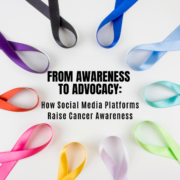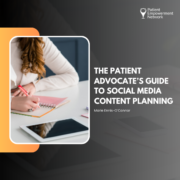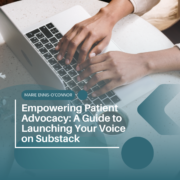From Awareness to Advocacy: How Social Media Platforms Raise Cancer Awareness
Social media is a powerful tool. While most of us use it casually or for entertainment purposes, it’s also a major resource for businesses and organizations.
But, social media isn’t just a way for you to keep in touch with family and friends or to check out your favorite businesses. It can also be used as an incredible opportunity to spread awareness about important issues and causes – including cancer.
Because of the community aspect of social media, it’s not only easy to spread awareness, but it’s possible to mobilize local communities across the world for advocacy.
With that in mind, let’s look at how various social media platforms contribute to raising cancer awareness, and the impact they have on empowering individuals, advocacy groups, nonprofits, and more to become advocates for cancer-related causes.
Recognizing the Power of Social Media
Chances are, you’re on at least one social media platform. Many people are active on several. Almost everyone you know is probably involved with at least one, too. But, don’t just look to yourself or your inner circle to consider the power of these platforms. When you take a look at the numbers and start associating them with the spread of awareness, you’ll see just how powerful these platforms can be. Today’s top social media sites are:
- YouTube
- TikTok
- Snapchat
The interesting thing about these platforms is that they have different audiences. There’s some overlap, of course, and there is no age limit on who can use different social media sites. But, when you’re trying to spread awareness and boost advocacy, you have to consider who you’re talking to. For example, platforms like TikTok and Snapchat are going to feature a younger demographic.
That’s not a bad thing, it just might require you to adjust your message to different audiences. Your main goal, with any platform, should be to provide real, accurate information that builds trust. Unfortunately, there is so much misinformation out there nowadays, and every time it pops up on a social media platform, some people might believe it, setting back true awareness even further.
Building Communities Through Social Media
Interacting with your family and friends on social media is great, but if you’re trying to spread awareness about cancer, it’s important to branch out. Social media gives you the opportunity to connect with complete strangers and end up forming a community of friends – even if you’ve never met in person.
There are plenty of online communities dedicated to awareness and advocacy, even from the American Cancer Society. Some of the largest organizations featured by the ACS include CaringBridge, Cancer Survivors Network (CSN), the National Cancer Information Center, (NCIC), and Reach to Recovery. Any of these options can help you find the support you deserve in an online setting, and while they each have their own website and/or app, they also have a strong social media presence that can help you connect with others who might be dealing with the same health issues.
But, starting a grassroots community on social media can sometimes be more powerful. It’s honest and real without any hoops to jump through. People can invite their own friends and family, and it can continue to grow via word of mouth. It will give people the opportunity to speak freely, share their stories, and educate others along the way.
While building a community is a great way to communicate with others, you can go further than that by connecting with caregivers or creating a safe place for caregivers to offer their services. You can create a community that fosters support throughout the diagnosis and treatment process. You could even provide regular information about cancer research and opportunities for treatment – if you’re willing to back up every claim with the help of healthcare providers.
Your community could even be a source of comfort and inspiration for caregivers. They often need support and encouragement, even if it’s from a group of people online that understand what they’re dealing with every day.
If you want your social media communities to grow, don’t hesitate to do a bit of marketing. Your goal should be to attract attention and get people talking. Once your community starts to grow, some of the most important rules for helping it to thrive include:
- Being responsive
- Empowering followers to take action
- Engaging with user-generated content
- Staying on-brand and being relatable
It’s also important for your community to feel safe and heard. It’s not always easy for people to open up online, and if you want nonprofit or advocacy groups to join you, they need assurance that their information and data will be kept safe. That’s especially true if they’re providing you with personal health stories or giving you financial information to boost awareness or grow your community.
If you’re going to be in charge of an online community, be sure you understand the basics of cybersecurity. Things like installing risk-based management systems, utilizing advanced email security, and requiring multi-factor authentication to log in to certain back-end sites will help to keep you safe while protecting the information and data of your community.
Taking Things Offline
Building awareness via social media is only the first step. It’s an important one, and you could end up doing more for yourself and other people with cancer than you ever expected. It’s easy for some people with cancer to feel alone, or even hopeless. By fostering a community on social media, you can provide them with support, friendship, and understanding. You can connect them with others who might be in the same situation, or people who have beat the disease and are on the other side of it, enjoying life.
But, at some point, it will be time to encourage the community you’ve built on social media to step out into the real world and take action.
Advocacy in the real world takes many forms. It can be something as simple as volunteering for a support group, listening to and sharing personal stories, or even visiting those who have recently been diagnosed with cancer.
When you’ve used social media to build a community, though, you can go even bigger with your advocacy efforts. Create events on your platforms designed to educate the public about cancer. They might include things like marches or gatherings, speaking at community centers, or attending events at schools or healthcare facilities to hand out accurate information and connect with others in person.
You can also encourage your social media friends and followers to advocate on their own within their communities. The beauty of social media is that it spreads all over the world. People can help by:
- Participating in fundraisers
- Donating money to a cancer relief group
- Speaking with community groups
- Communicating with local media
- Changing public policy
Again, social media is a powerful tool. While we might often view it as something fun, or even something we use to pass the time, it can be used for good – and even to change the world. Keep these ideas in mind to go from awareness to advocacy, and you could end up being a social media superhero.
Miles is an independent writer with a background in business and passion for tech, health, news, and simply helping people live happy and fulfilled lives. He has lived and traveled all over the United States and continues to expand his awareness and experiences. When he is not writing, he is most likely mountain biking or kicking back with a cup of tea.










